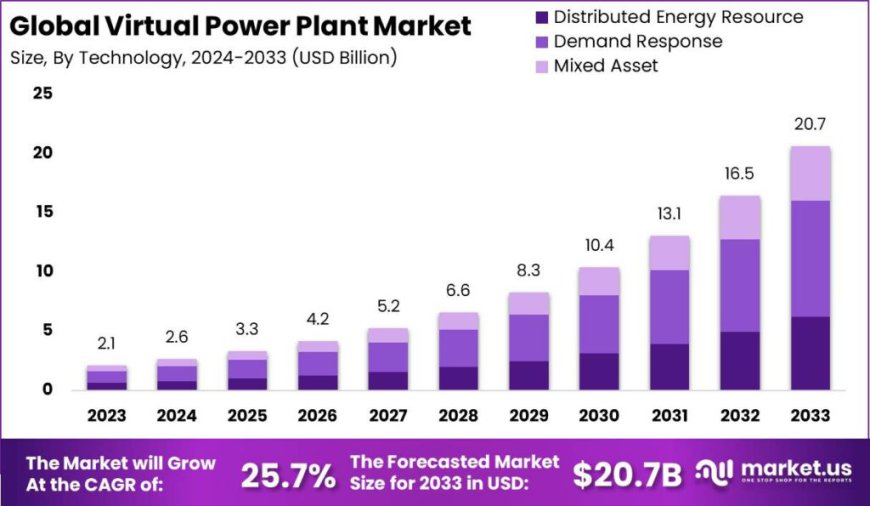Virtual Power Plant Market: Smart Energy Integration

Introduction
The Global Virtual Power Plant Market size is expected to be worth around USD 20.7 Billion By 2033, from USD 2.1 Billion in 2023, growing at a CAGR of 25.7% during the forecast period from 2024 to 2033.
A Virtual Power Plant (VPP) is an innovative system that integrates various decentralized energy sources like solar panels, wind turbines, and batteries to operate as a single power plant. This technology optimizes the generation, storage, and consumption of renewable energy, enhancing grid reliability and efficiency. The VPP market is witnessing rapid growth due to several factors. Rising energy demand, the push for renewable energy sources, advancements in technology, and favorable government policies are significant drivers. However, challenges like high initial setup costs, cybersecurity risks, and the need for robust regulatory frameworks persist. Despite these challenges, the VPP market presents substantial opportunities, including improved energy efficiency, reduced carbon emissions, and enhanced grid stability.
Read More - https://market.us/report/virtual-power-plant-market/
Emerging Trends
- Integration with Smart Grids: VPPs are increasingly being integrated with smart grid technology, allowing for real-time monitoring and management of energy resources.
- AI and Machine Learning: The use of AI and machine learning for predictive maintenance and optimization of energy distribution is on the rise.
- Blockchain Technology: Blockchain is being explored for secure and transparent energy transactions within VPPs.
- Peer-to-Peer Energy Trading: Emerging platforms enable consumers to trade excess energy with their peers, enhancing the flexibility and efficiency of VPPs.
- Decentralized Energy Storage: Advances in battery technology and energy storage solutions are supporting the decentralization of power plants.
Top Use Cases
- Grid Stabilization: VPPs help stabilize the grid by balancing supply and demand, reducing the risk of blackouts.
- Peak Shaving: VPPs reduce the demand during peak hours by distributing energy more efficiently, leading to cost savings for both providers and consumers.
- Renewable Integration: They facilitate the integration of renewable energy sources into the grid, making it easier to manage intermittent energy production.
- Emergency Backup: VPPs provide backup power during emergencies or grid failures, ensuring a reliable energy supply.
- Energy Trading: VPPs enable energy trading among consumers, enhancing market efficiency and allowing consumers to benefit financially from their excess energy production.
Major Challenges
- High Initial Costs: The setup costs for VPP infrastructure, including advanced software and hardware, can be prohibitively high.
- Cybersecurity Risks: VPPs are vulnerable to cyber-attacks, which can disrupt operations and compromise data security.
- Regulatory Hurdles: Inconsistent and evolving regulations across different regions can hinder the deployment and operation of VPPs.
- Technological Integration: Ensuring seamless integration of various energy sources and storage systems requires sophisticated technology and coordination.
- Consumer Awareness: Lack of awareness and understanding among consumers about the benefits and functioning of VPPs can slow market adoption.
Market Opportunity
- Growing Energy Demand: The increasing global energy demand presents a significant opportunity for VPPs to optimize energy distribution and consumption.
- Renewable Energy Push: The global shift towards renewable energy sources creates a vast market for VPPs to manage and distribute renewable power efficiently.
- Government Incentives: Favorable government policies and incentives for renewable energy projects support the growth of the VPP market.
- Technological Advancements: Continuous advancements in AI, blockchain, and energy storage technologies provide opportunities for enhancing VPP capabilities.
- Environmental Benefits: The environmental benefits of reduced carbon emissions and increased energy efficiency drive the adoption of VPPs, aligning with global sustainability goals.
Conclusion
The Virtual Power Plant market is poised for significant growth, driven by the increasing demand for reliable and efficient energy solutions. With the integration of advanced technologies like AI, blockchain, and smart grids, VPPs offer a promising solution to the challenges of modern energy management. Despite the hurdles of high initial costs, cybersecurity concerns, and regulatory complexities, the benefits of enhanced grid stability, renewable energy integration, and economic opportunities for consumers make VPPs an attractive option. As awareness and technology continue to advance, VPPs are set to play a crucial role in the future of energy systems, contributing to a more sustainable and resilient energy infrastructure.
